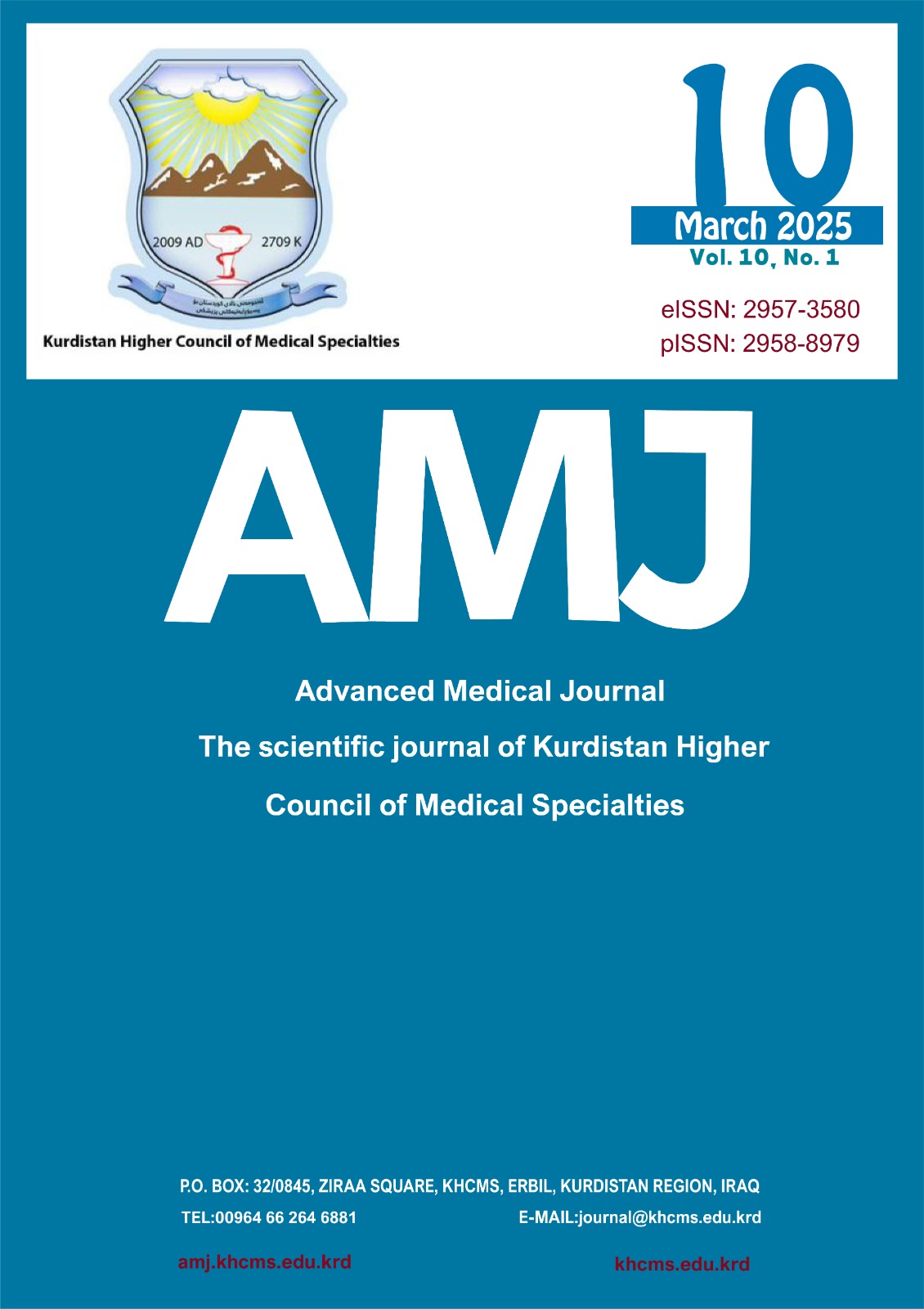Sacrococcygeal Pilonidal Sinus Diseases and Operative Management at Burn and Plastic Hospital in Duhok City
DOI:
https://doi.org/10.56056/amj.2025.325Keywords:
Complication, Pilonidal sinus, Operative managementAbstract
Background and objectives: Pilonidal sinus diseases usually seen in young adults, carry much morbidity and patient discomfort. The management is the most critical issue in surgical treatment because it is related to postoperative morbidity and recurrence. So, this study aims to explore sacrococcygeal pilonidal sinus diseases and the operative methods achieved in Burn and Plastic hospital in Duhok City.
Methods: A descriptive study includes 55 cases of Pilonidal Sinus disease, 50 males and five females aged between 19 and 50 years who were admitted to Burn and Plastic Hospital in Duhok City during 2018-2019 for surgical operations. Different surgical procedures were achieved including close and open methods, fascia cutaneous flaps, and skin grafts. After discharge, most of the patients attended the outpatient clinic for follow, and complications were recorded. So, this study explores the prevalence and type of surgical management used to treat them.
Results: This study showed that males were affected more than females (9:1) ratio; in the age of the second decade (47.2%). The common presentation was chronic multiple sinuses (63.6%). Operations were achieved by closed method (54.5%), flap operation (31%), open method (7%), skin graft (3.6%), and abscess drainage (3.6%). The common postoperative complication was seroma (7.2%), recurrence (5.4%), hematoma (3.6%), and wound disruption (3.6%).
Conclusion: Pilonidal is a common surgical among young adult males than females. Many conventional and flap surgical procedures are applied. It is mandatory to try many flap operations and follow up on them strictly to find the best treatment and fewer complications.
Downloads
References
-Milone M, Basso L, Manigrasso M, Pietroletti R, Bondurri A, La Torre M, et al. Consensus statement of the Italian society of colorectal surgery (SICCR): management and treatment of pilonidal disease. Tech Coloproctol. 2021 Dec;25(12):1269-80. doi: 10.1007/s10151-021-02487-8/
-Gündo?du E. Fasciocutaneous Elliptical Rotation Flap for Pilonidal Sinus Disease and Its Outcomes. Turk J Surg. 2020 Sep; 36(3): 310–316.
- Hap W, Frejlich E, Rudno-Rudzi?ska J, Kotulski K, Kurnol K, Hap K, et al. Pilonidal sinus: finding the righttrack for treatment. Polski przeglad chirurgiczny. 2017;89(1):68-75.
- Evers T, Doll D, Matevossian E, Noe S, Neumann K, Li HL, et al. Trends in incidence and long-term recurrence rate of pilonidal sinus disease and analysis of associated influencing factors. Zhonghua wai ke za zhi. 2011;49(9):799.
- Luedi MM, Kauf P, Evers T, Sievert H, Doll D. Impact of spinal versus general anesthesia on postoperative pain and long-term recurrence after surgery for pilonidal disease. J Clin Anesth. 2016; 33:236-42.
- Nelson J, Billingham R. Pilonidal disease and hidradenitis suppurativa. The ASCRS textbook of colon and rectal surgery. New York: Springer. 2007:228-35.
- Mahdy T. Surgical treatment of the pilonidal disease: primary closure or flap reconstruction after excision. Dis Colon Rectum. 2008;51(12):1816-22.
- Mahmood F, Hussain A, Akingboye A. Pilonidal sinus disease: review of current practice and prospects for endoscopic treatment. Ann. Med. Surg. 2020; 57, 212-217.
- Da Silva JH. Pilonidal cyst. Dis colon rectum. 2000;43(8):1146-56.
- Alkatta MA., Mejally A. Excision and tension-free primary closure of pilonidal disease. Turk J Surg. 2019; 35(4), 278.
-Doll D, Orlik A, Maier K, Kauf P, Schmid M, Diekmann M, Luedi MM. Impact of geography and surgical approach on recurrence in global pilonidal sinus disease. Sci. Rep. 2019; 9(1), 15111.
- Hull TL, Wu J. Pilonidal disease. Surg Clin North Am. 2002;82(6):1169-85.
- Steele SR, Perry WB, Mills’ S, Buie WD. Practice parameters for the management of pilonidal disease. Dis colon rectum. 2013;56(9):1021-7.
- Bi S, Sun K, Chen S, Gu J. Surgical procedures in the pilonidal sinus disease: a systematic review and network meta-analysis. Sci. Rep. 2020; 10(1), 13720.
- Doll D, Luedi MM, Evers T, Kauf P, Matevossian E. Recurrence-free survival, but not surgical therapy per se, determines 583 patients’ long-term satisfaction following primary pilonidal sinus surgery. Int. J. Colorectal Dis. 2015;30(5):605-11.
- Sievert H, Evers T, Matevossian E, Hoenemann C, Hoffmann S, Doll D. The influence of lifestyle (smoking and body mass index) on wound healing and long-term recurrence rate in 534 primary pilonidal sinus patients. Int. J. Colorectal Dis. 2013;28(11):1555-62.
- Milone M, Velotti N, Manigrasso M, Anoldo P, Milone F, & De Palma, GD. Long-term follow-up for pilonidal sinus surgery: a review of literature with metanalysis. The Surgeon. 2018;16(5), 315-320.
-Varnalidis I, Ioannidis O, Paraskevas G, Papapostolou D, Malakozis SG, Gatzos S, et al. Pilonidal sinus: a comparative study of treatment methods. J Med Life. 2014;7(1):27.
-Mahdy T. Surgical treatment of the pilonidal disease: primary closure or flap reconstruction after excision. Dis Colon Rectum. 2008;51(12):1816-22.
-Ersoy OF, Kayaoglu HA, Ozkan N, Celik A, Karaca S, Ozum T. Comparison of different surgical options in the treatment of pilonidal disease: retrospective analysis of 175 patients. Kaohsiung J Med Sci. 2007 Feb;23(2):67-70.
- Stauffer VK, Luedi MM, Kauf P, Schmid M, Diekmann M, Wieferich K, et al. Common surgical procedures in pilonidal sinus disease: a meta-analysis, merged data analysis, and comprehensive study on recurrence. Sci Rep, 2018;8(1):1-28.
- Mohakud NK, Yerru Jr H, Rajguru M, Naik SS. An Assumed Vertical Transmission of SARS-CoV-2 During Pregnancy: A Case Report and Review of Literature. Cureus. 2020;12(9); e10659. doi: 10.7759/cureus.10659.
-Onder A, Girgin S, Kapan M, Toker M, Arikanoglu Z, Palanci Y, et al. Pilonidal sinus disease: risk factors for postoperative complications and recurrence. Int. Surg. 2012;97(3):224-9.
Downloads
Published
Issue
Section
License
Copyright (c) 2025 Kareem Muhammed Ahmed

This work is licensed under a Creative Commons Attribution-NonCommercial-ShareAlike 4.0 International License.
The copyright on any article published in AMJ (The Scientific Journal of Kurdistan Higher Council of Medical Specialties )is retained by the author(s) in agreement with the Creative Commons Attribution Non-Commercial ShareAlike License (CC BY-NC-SA 4.0)














